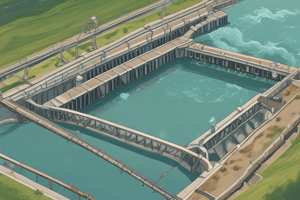Podcast
Questions and Answers
What is effluent?
What is effluent?
Effluent is the liquid waste or sewage that is discharged into water bodies.
Define contaminants.
Define contaminants.
Contaminants are substances that pollute other substances, such as water or food.
What are organic impurities in sewage?
What are organic impurities in sewage?
Organic impurities in sewage include animal waste, urine, oil, vegetable and fruit waste, faeces, pesticides, and herbicides.
List two examples of inorganic impurities.
List two examples of inorganic impurities.
What are pathogenic bacteria?
What are pathogenic bacteria?
What is sewage?
What is sewage?
What is wastewater and what are some characteristics of it?
What is wastewater and what are some characteristics of it?
Why is clean water considered a basic need for survival?
Why is clean water considered a basic need for survival?
What is sewage and why is it important to treat it before discharging into water bodies?
What is sewage and why is it important to treat it before discharging into water bodies?
Explain the process of sewage treatment and its significance.
Explain the process of sewage treatment and its significance.
How does the discharge of sewage into river bodies impact the environment?
How does the discharge of sewage into river bodies impact the environment?
Describe the journey of sewage from its production to disposal.
Describe the journey of sewage from its production to disposal.
What is the purpose of manholes in a sewerage system?
What is the purpose of manholes in a sewerage system?
Describe the process of treating wastewater in a wastewater treatment plant.
Describe the process of treating wastewater in a wastewater treatment plant.
What is the role of bacteria in the wastewater treatment process?
What is the role of bacteria in the wastewater treatment process?
Explain the importance of disinfecting water in the wastewater treatment process.
Explain the importance of disinfecting water in the wastewater treatment process.
How can poor sanitation contribute to the spread of diseases?
How can poor sanitation contribute to the spread of diseases?
What is an alternative arrangement for sewage disposal mentioned in the text?
What is an alternative arrangement for sewage disposal mentioned in the text?
Study Notes
Wastewater and Sewage
- Wastewater refers to all effluent from households, hospitals, commercial organizations, and institutions, including agricultural, horticultural, stormwater, and urban runoff, and aquaculture effluent.
- Effluent is the liquid waste or sewage discharged into water bodies from treatment plants or direct sources.
Contaminants and Impurities
- A contaminant is something that contaminates a substance, such as water or food.
- Organic impurities include animal waste, urine, oil, vegetable and fruit waste, faeces, pesticides, and herbicides.
- Inorganic impurities include phosphates, nitrates, and metals, which do not contain carbon, except for some inorganic impurities like carbon dioxide.
Bacteria and Sewage
- Bacteria are tiny forms of life that can only be seen with a microscope.
- Harmful bacteria that cause bacterial infections and disease are called pathogenic bacteria.
- Pathogenic bacteria can cause diseases like typhoid, cholera, and pneumonia.
Sewage Treatment
- Sewage is wastewater released by hospitals, homes, or industrial establishments that is carried away in sewers or drains for dumping or conversion into a non-toxic form.
- Sewage contains disease-causing bacteria and other microbes that can spread diseases.
- Discharging sewage into rivers contaminates freshwater sources, leading to water scarcity and other problems.
Water and Wastewater Treatment
- Clean water is a basic need for human survival, but many people lack access to clean water, leading to water-related diseases.
- The process of treating wastewater to remove pollutants is called sewage treatment.
- Wastewater treatment involves physical, chemical, and biological processes to treat wastewater.
Wastewater Treatment Plant
- Wastewater treatment plants use physical, chemical, and biological processes to treat wastewater.
- The treatment process involves bar screens, grit and sand removal tanks, and aeration tanks.
- Bacteria consume unwanted matter in the water, and the activated sludge is removed, disinfected, and reused.
Better Housekeeping Practices
- Measures to decrease sewage formation include:
- Not throwing vegetable oil and fats down the drain
- Not discharging chemicals into the drain
- Throwing waste into the dustbin instead of down the drain
Sanitation and Disease
- Poor sanitation and contaminated drinking water are major causes of diseases like cholera, typhoid, polio, and dysentery.
- Open defecation leads to water and soil pollution, harming human health.
Alternative Arrangement for Sewage Disposal
- On-site sewage disposal systems use biogas plants to process excreta, producing energy.
Sanitation at Public Places
- The government has laid down standards for sanitation at public places.
Studying That Suits You
Use AI to generate personalized quizzes and flashcards to suit your learning preferences.
Description
Test your knowledge on wastewater, effluent, contaminants, and organic impurities. Learn about the different sources of wastewater and the impact of contaminants on water bodies.





